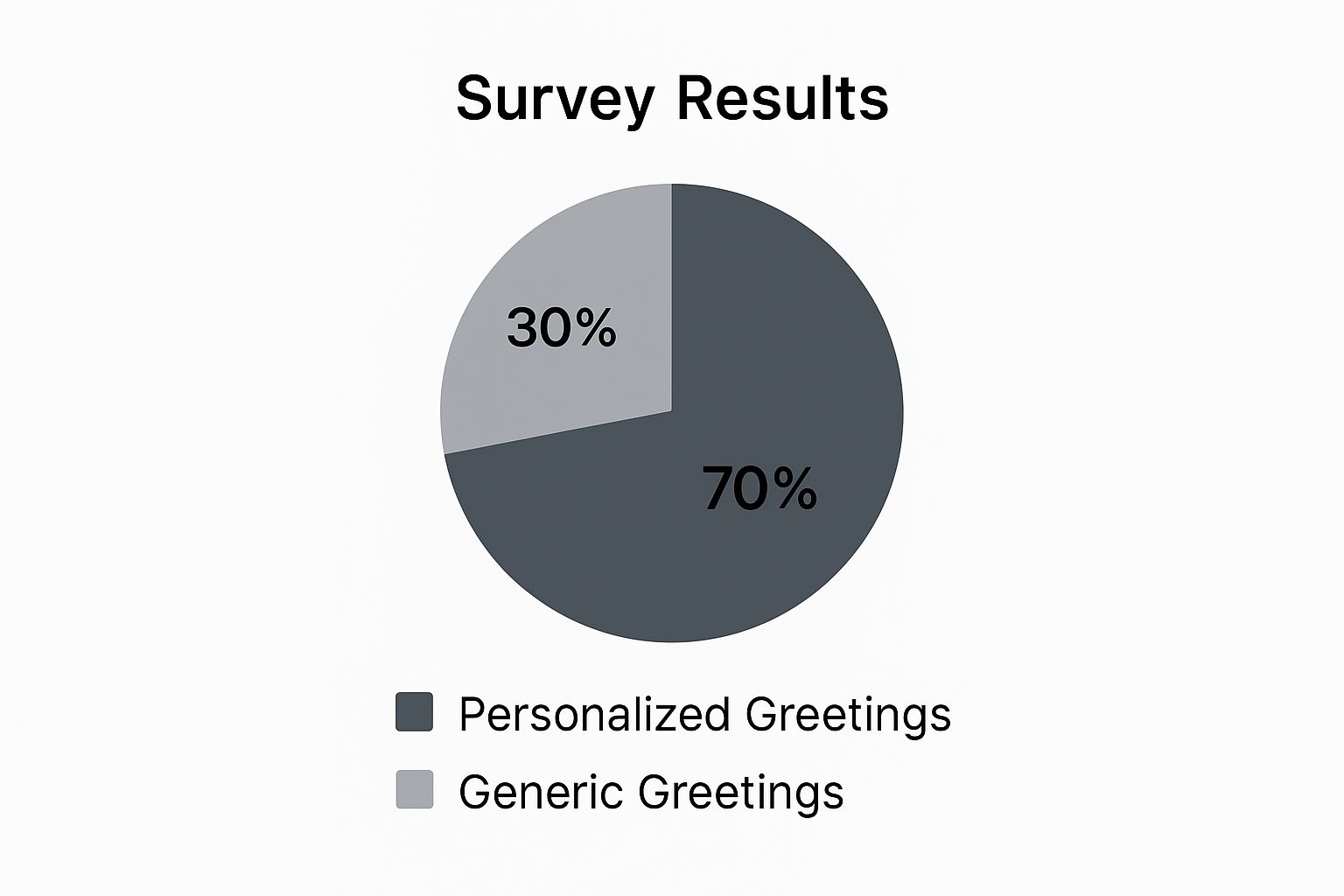Knowing exactly who to address your cover letter to is one of the easiest ways to make a powerful first impression. When you take the time to find the right person, such as the hiring manager, it immediately signals your diligence and genuine interest. It is a small detail that sets you apart from the stack of generic applications.
Why Your Cover Letter Salutation Matters

That opening line on your cover letter does a lot more than just say hello. It sets the entire tone for your application. A bland, generic greeting like ‘To Whom It May Concern’ can come across as impersonal and lazy, suggesting you have not bothered to do the bare minimum.
Ditching that outdated phrase shows you have invested time in researching the company and the role. This simple act communicates professionalism, attention to detail, and a proactive attitude—all traits that hiring managers look for.
The Impact of a Personalised Greeting
A personalised salutation is a strategic move. It instantly creates a human connection, turning your application from just another document into a direct message for a real person. This small detail can be the very thing that gets your application moved from the 'maybe' pile to the 'yes' pile.
In a competitive job market, this level of detail is critical. In fact, cover letters are so important that a staggering 90% are rejected due to a lack of customisation, which absolutely includes failing to address the right person. That statistic alone shows just how vital it is to get the greeting right.
Your cover letter is often the first real interaction a hiring manager has with you. Making it personal shows respect for their time and proves you are a candidate who goes the extra mile.
Connecting Your Cover Letter and Resume
Ultimately, a strong cover letter works hand-in-hand with your resume. The cover letter creates that initial spark and connection, but both documents need to be polished and professional to land you an interview.
For more guidance, you can explore our expert advice on writing a standout resume. Nailing these foundational elements gives you the best possible shot at success.
How to Find the Right Person to Address
Let's move past the guesswork. A little bit of detective work here can make a huge difference, showing you are resourceful before you even get an interview.
Your first port of call should almost always be LinkedIn. It is far more than just a place to park your CV; it is a living, breathing directory of nearly every company out there.
Uncover Clues on LinkedIn
Instead of just searching for a job title, head straight to the company’s LinkedIn page and find the 'People' tab. It is a goldmine that too many people ignore, and it gives you a fantastic peek inside the company's structure.
From there, you can filter employees by keywords. Think about the department you are applying for, like 'Marketing', 'IT', or 'Project Management'. This simple search can quickly show you potential team leads, department heads, or even the exact person in charge of hiring for the role.
This strategy is not just about finding a name; it shows you have taken the time to understand how their teams are put together and that you are serious about making a genuine connection.
Scour the Company Website
Do not forget the company's own website. Always start with the 'About Us' or 'Our Team' pages. You would be surprised how often they list key leadership profiles with names and job titles right there.
Another valuable spot is the 'News' or 'Press Releases' section. If a company has announced a new project or a team expansion, they often mention the key players by name. This could give you the exact name of a department head or the person leading the project you want to join.
A few extra minutes spent on this kind of research can be the difference between your application feeling generic and one that feels personal and directed. It is a small effort for a massive payoff.
Try a Direct and Professional Approach
What if your digital digging turns up nothing? Do not give up. It is time to pick up the phone. A quick, polite call to the company's reception can often get you the answer you need.
Here is a simple script you can use:
- "Good morning. My name is [Your Name], and I am preparing an application for the [Job Title] position. To make sure my cover letter gets to the right person, could you please tell me who the hiring manager is for the [Department Name] department?"
It is a direct approach, but it is surprisingly effective and shows a lot of confidence. If a call is not an option, exploring various contact finder tools can also be a massive help. These are the real-world tactics that will get your application noticed.
Choosing the Right Salutation and Format
So, you have put in the hard yards and found the hiring manager's name. Nicely done. But the job is not over yet. How you address them in your cover letter can set the tone for your entire application.
Getting this right is not about clinging to old-fashioned rules; it is about showing you are a professional who pays attention to detail. It is a small touch that reinforces the great first impression you are trying to make, and it shows you understand professional norms.
This is not just a hunch, either. The data backs it up.

As you can see, a significant majority of hiring managers prefer a personalised greeting. This simple step has moved from a 'nice-to-have' to a non-negotiable part of a winning application strategy.
Navigating Titles and Formality
The trick is to match your tone to the company culture. A little bit of research into the organisation's vibe will go a long way here.
For more traditional sectors like law, finance, or government, it is always best to play it safe and stick with a formal approach.
- Formal Salutation: Use their title and surname. Think "Dear Ms Smith," or "Dear Dr Evans." It is classic for a reason.
- Default Title for Women: Always use ‘Ms.’ as your default. It is the professional standard and avoids making assumptions unless you know for certain they prefer another title.
- Academic or Professional Titles: If you find the person has a title like 'Dr.' or 'Professor', make sure you use it. It is a sign of respect for their hard-earned credentials.
If you are applying to a tech start-up or a creative agency, the culture might be more relaxed. Even so, a safe bet is "Dear [First Name] [Last Name]". This format hits the sweet spot—it feels modern and professional without being overly stiff or too familiar.
There is a lot to weigh up, and you can dive deeper into the nuances in our complete guide on what you should know about cover letters in 2025.
Your Guide to Cover Letter Salutations
In a competitive job market, personalising your cover letter gives you a real edge. It signals genuine interest and initiative—two things every employer is looking for. A generic "To Whom It May Concern" should only ever be your absolute last resort when you have exhausted all other options.
To help you pick the perfect greeting, here is a quick reference table breaking down your options.
| Salutation Type | When to Use It | Example |
|---|---|---|
| Formal Title | Best for traditional industries (law, finance) or when addressing very senior leadership. Shows classic professionalism. | "Dear Mr Jones," |
| Full Name | The safest, most reliable option for almost any role. It is modern, respectful, and professional. | "Dear Jane Citizen," |
| First Name Only | Use with caution. Only suitable if the company culture is known to be very casual or if you have a referral. | "Dear Jane," |
Think of your salutation as the first handshake. It is a small but powerful gesture that can start your application off on the right foot and show the reader you are a candidate who truly cares.
What to Write When You Cannot Find a Name
Let's be realistic—sometimes, no matter how deep you dig, a name just will not surface. You have scoured LinkedIn, dissected the company’s website, and you have still come up empty-handed. It happens.
When you hit this wall, whatever you do, please do not resort to the dusty, old-fashioned salutations like ‘Dear Sir/Madam’ or the dreaded ‘To Whom It May Concern’. These are instant red flags for recruiters. They suggest you have not put in the effort and can make your application feel like just another piece of paper in the pile.
Your fallback plan needs to be just as professional and targeted as if you had the name.
Opt for a Role or Department Title
Your best bet is to address the specific role or the department to which you are applying. This is a sharp, modern approach that shows you have at least thought about who will be reading your application, even if you could not pinpoint the exact person.
Think about it from their perspective. An application addressed to the "Senior Marketing Manager" feels far more intentional than a generic, catch-all greeting.
Here are a few solid, go-to options that work well:
- "Dear Hiring Manager": This is the universal safe bet. It is professional, direct, and widely accepted.
- "Dear Senior Project Manager": Use this when the job description clearly states the title of the person you would be reporting to. It is specific and shows you are paying attention.
- "Dear Marketing Department Hiring Team": A great choice for larger companies where you know a team is likely handling the initial screening.
The goal is to get as specific as possible. By addressing the role, you demonstrate an understanding of the company's structure and keep your cover letter feeling purposeful right from the first line.
Your cover letter is a document that works alongside your resume to tell a cohesive story. Addressing it correctly, even without a name, is a critical step. To ensure the rest of your submission is just as sharp, check out our comprehensive guide on what to write when sending a resume.
This small tweak makes a huge difference. It shows you are a thoughtful and diligent candidate who does their homework, setting a professional tone before they have even read your first paragraph.
Common Mistakes to Avoid at All Costs

You have put in the time to craft a brilliant cover letter. The last thing you want is for a simple, avoidable slip-up to send it straight to the 'no' pile. Figuring out who to address a cover letter to is half the battle; avoiding these common blunders is the other half.
One of the most cringe-worthy mistakes is misspelling the hiring manager’s name. It screams carelessness and a lack of attention to detail—two qualities no employer is looking for. It can come across as disrespectful and immediately sours the first impression you are trying to make.
Another classic error is sending your letter to the wrong person altogether. Think about it: a beautifully written application for a marketing role landing on the desk of the Head of IT. It just shows you have not done your homework.
Navigating Titles and Tone
Getting the title right, especially for a female contact, can feel like walking on eggshells, but there is a simple rule of thumb. When in doubt, always use ‘Ms.’. It is the professional standard because it does not refer to marital status, making it the safest and most respectful option.
The tone of your salutation also matters—a lot. Getting it wrong can make you seem out of touch with the company's culture.
- For a corporate law firm: Opening with "Hey Jane," is a deal-breaker. It is far too casual and signals that you do not understand the professional environment.
- A better approach: Stick with a respectful "Dear Ms Citizen," or "Dear Jane Citizen," to set the right tone from the very beginning.
On the flip side, an overly formal greeting can feel just as awkward. Addressing the hiring manager at a laid-back creative start-up with "Dear Sir," might make you seem stuffy and disconnected from their culture.
Nailing these small details is the final quality check on your application. It proves you are a thoughtful, professional candidate who knows how to read the room.
Got Questions? We’ve Got Answers
You are not alone if you have ever felt stuck on the salutation. Getting the small details right can feel surprisingly high-stakes. Here are some quick answers to the most common questions we hear from jobseekers.
Can I Still Use ‘To Whom It May Concern’?
It is best to avoid this one. In the modern job market, it comes across as quite dated and, worse, a little lazy. It gives the impression you have not put in the effort to find out who you are actually writing to.
If you have exhausted all your research options and come up empty, a better fallback is something like ‘Dear Hiring Manager’ or even ‘Dear [Department Name] Team’. It is a small change that feels much more current.
What if I’m Sending My Application to a Generic Email?
You might see an address like 'careers@company.co.uk' and think a specific name does not matter. But remember, a real person on the other end will eventually read your application.
Your goal is to make sure your cover letter gets to the right person. Even if it lands in a general inbox first, addressing it to the actual department head or hiring manager makes it far more likely to be forwarded to them personally.
Think of it this way: the generic email is just the post office. Your cover letter is a direct message meant for a specific decision-maker. Make sure it is addressed accordingly.
Ms. or Mrs.? What’s the Right Title to Use?
This one is easy: when in doubt, always use ‘Ms.’.
It is the professional standard because it does not refer to marital status, making it the most respectful and appropriate choice for business communication. Unless you see a person's title specified as ‘Mrs.’ or ‘Dr.’ on their LinkedIn profile or company bio, ‘Ms.’ is your safest bet.
Finding the right talent is just as crucial as finding the right role. If you are a business looking for a trusted, high-performing recruitment partner, the expert team at Redwolf Rosch can help. Get in touch for an introductory discussion today.
 Submit CV
Submit CV Submit vacancy
Submit vacancy  Call for a Candidate
Call for a Candidate